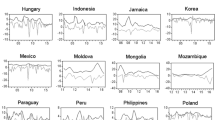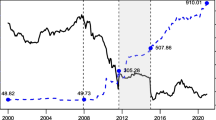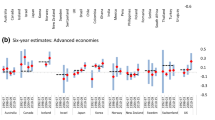Abstract
In this paper we propose a generalisation of the noise trader transmission mechanism to examine the impact of central bank intervention on exchange rates. Within a heterogeneous expectation exchange rate model intervention operations are supposed to provide support for chartist or fundamentalist forecasts, which forces portfolio managers to adjust their foreign currency positions. The empirical examination of the hypothesis is done by applying a Markov regime-switching approach to daily DEM/US-dollar exchange rates and intervention data of the Deutsche Bundesbank and the Federal Reserve from 1979 to 1992. It is shown that chartist’s profits rose whenever these central banks intervened on the foreign exchange market. This is not true for those who follow a fundamentalist approach.
Similar content being viewed by others
References
Baillie, R. and W. Osterberg (1997a) “Central Bank Intervention and Risk in the Forward Market.” Journal of International Economics 43:483–497.
Baillie, R. and W. Osterberg (1997b) “Why Do Central Banks Intervene?” Journal of International Money and Finance 16:909–919.
Brock, W. and C. Hommes (1998) “Heterogeneous Beliefs and Routes to Chaos in a Simple Asset Pricing Model.” Journal of Economic Dynamics Control 22:1235–1274.
Clarida, R., L. Sarno, M. Taylor, and G. Valente (2001) “The Out-of-Sample Success of Term Structure Models as Exchange Rate Predictors: A Step Beyond.” Mimeo.
DeLong, J.B., A. Shleifer, L. Summers, and R. Waldman (1990) “Noise Trader Risk in Financial Markets.” Journal of Political Economy 98:703–738.
De Grauwe, P. (1994) “Exchange Rates in Search of Fundamental Variables.” (CEPR Discussion Paper) 1073.
De Grauwe, P. and H. Dewachter (1993) “A Chaotic Model of the Exchange Rate: The Role of Fundamentalists and Chartists.” Open Economies Review 4:351–379.
Dewachter, H. (2001) “Can Markov Switching Models Replicate Chartist Profits in the Foreign Exchange Market?” Journal of International Money and Finance 20:25–41.
Dominguez, K. (1998) “Central Bank Intervention and Exchange Rate Volatility.”Journal of International Money and Finance 17:161–190.
Dominguez, K. and J. Frankel (1993a) “Does Foreign-Exchange Intervention Matter? The Portfolio Effect.” American Economic Review 83:1356–1369.
Dominguez, K. and J. Frankel (1993b) Does Foreign-Exchange Intervention Work? Washington, D.C: Institute for International Economics.
Dooley, M. and J. Shafer (1983) “Analysis of Short-Run Exchange Rate Behavior: March 1979 to November 1981.” In D. Bigman and T. Taya (eds.), Exchange Rate and Trade Instability: Causes, Consequences and Remedies. Ballinger Cambridge.
Engel, Ch. (1994) “Can the Markov Switching Model Forecast Exchange Rates?” Journal of International Economics 36:151–165.
Engel, Ch. and J. Hamilton (1990) “Long Swings in the Dollar: Are They in the Data and Do Markets Know It?” American Economic Review 80:689–713.
Farmer, D. and S. Joshi (2002) “The Price Dynamics of Common Trading Strategies.” Journal of Economic Behavior and Organization, 49:149–171.
Fatum, R. and M. Hutchison (2002) “ECB Foreign Exchange Intervention and the Euro: Institutional Framework, News, and Intervention.” Open Economies Review 13:413–425.
Frankel, J. and K. Froot (1986) “Understanding the US Dollar in the Eighties: The Expectations of Chartists and Fundamentalists.” The Economic Record 62:24–38.
Hamilton, J. (1989) “A New Approach to the Economic Analysis of Nonstationary Time Series and the Business Cycle.” Econometrica 57:357–384.
Hommes, C. (2001) “Financial Markets as Nonlinear Adaptive Evolutionary Systems.” Quantitative Finance 1:149–167.
Hung, J. (1997) “Intervention Strategies and Exchange Rate Volatility: A Noise Trading Perspective.” Journal of International Money and Finance 16:779–793.
Kaminsky, G. and K. Lewis (1996) “Does Foreign Exchange Intervention Signal Future Monetary Policy?” Journal of Monetary Economics 37:285–312.
Klein, M. (1993) “The Accuracy of Reports of Foreign Exchange Intervention.” Journal of International Money and Finance 12:644–653.
LeBaron, B. (1999) “Technical Trading Rule Profitability and Foreign Exchange Intervention.” Journal of International Economics 49:125–143.
Lee, Ch., K. Gleason, and I. Mathur (2001) “Trading Rule Profits in Latin American Currency Spot Rates.” International Review of Fin. Analysis 10:135–156.
Lewis, K. (1989) “Changing Beliefs and Systematic Rational Forecast Errors with Evidence from Foreign Exchange.” American Economic Review 79:621–636.
Lux, T. (1995) “Herd Behaviour, Bubbles and Crashes.” Economic Journal 105:881–896.
Mussa, M. (1981) The Role of Official Intervention. Group of Thirty, New York.
Neely, C. (1997) “Technical Analysis in the Foreign Exchange Market: A Layman’s Guide.” Fed. R. Bank of St. Louis Review 79(5):23–38.
Neely, C. and P. Weller (2001) “Technical Analysis and Central Bank Intervention.” Journal of International Money and Finance 20:949–970.
Press, W., S. Flannery, S. Teukolsky, and W. Vettering (1988) Numerical Recipes in C. New York: Cambridge University Press.
Sarno, L. and M. Taylor (2001) “Official Intervention in the Foreign Exchange Market: Is It Effective and, If So, How Does It Work?” Journal of Economic Literature 39:839–868.
Takagi, S. (1991) “Exchange Rate Expectations, A Survey of Survey Studies.” IMF Staff Papers 38:156–183.
Taylor, M. and H. Allen (1992) “The Use of Technical Analysis in the Foreign Exchange Market.” Journal of International Money and Finance 11:304–314.
Taylor, M. and D. Peel (2000) “Nonlinear Adjustment, Long Run Equilibrium and Exchange Rate Fundamentals.” Journal of International Money and Finance 19:33–53.
Taylor, M., D. Peel, and L. Sarno (2001) “Nonlinear Adjustment in Real Exchange Rates: Torwards a Solution to the Purchasing Power Parity Puzzles.” International Economic Review 6:19–42.
Vigfusson, R. (1997) “Switching Between Chartists and Fundamentalists: A Markov Regime-Switching Approach.” International Journal of Financial Economics 2:291–305.
Westerhoff, F. (2003) “Central Bank Intervention and Feedback Traders.” Journal of International Financial Markets, Institutions and Money13:419–427.
White, H. (1982) “Maximum Likelihood Estimation of Misspecified Models.” Econometrica 50:1–25.
Author information
Authors and Affiliations
Corresponding author
Additional information
JEL Classification Numbers: F31, C32, E58, G15
Rights and permissions
About this article
Cite this article
Reitz, S. Central Bank Intervention and Heterogeneous Exchange Rate Expectations: Evidence from the Daily DEM/US-Dollar Exchange Rate. Open Econ Rev 16, 33–50 (2005). https://doi.org/10.1007/s11079-005-5331-2
Issue Date:
DOI: https://doi.org/10.1007/s11079-005-5331-2




